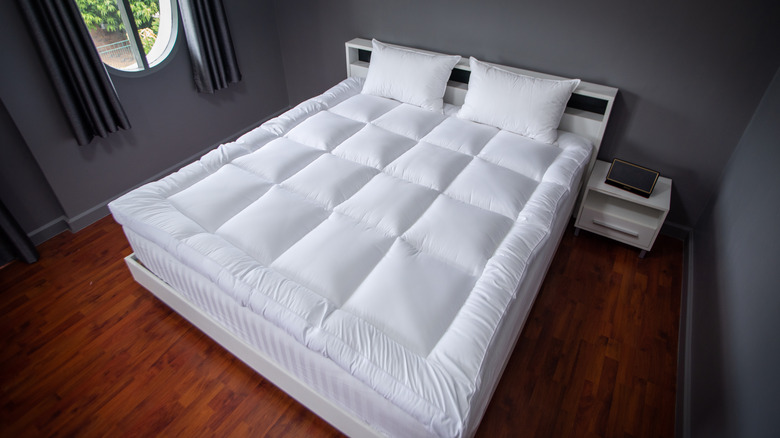The Best Way To Store Your Mattress Topper
Nothing allows you to channel your inner Goldilocks quite like the perfect mattress topper. The removable layer of material allows you to adjust the firmness level of a mattress so it becomes just right for you to achieve the best night's sleep. Given a mattress topper's invaluable ability to add cushion and comfort to your nighttime routine, it is critical to learn how to preserve its integrity when you are not using it — you need to master the fine art of cleaning, rolling, securing, and placing a mattress topper in the proper spot.
Unlike a mattress pad, a mattress topper is a substantial piece of bedding that can measure up to 4 inches thick, nearly double that of a pad. Its bulk is mainly attributed to memory foam, latex, wool, or feathers, which are used to cradle your body and protect the mattress. Thanks to its significant size and support capability, some homeowners add a topper to compensate for failing to choose the best mattress. However, when it comes time to move, all that extra comfort can leave you overwhelmed and wondering how you are going to store such a voluminous piece of bedding.
Start with a thorough cleaning
Before you get your roll on, the very first step to properly storing a mattress topper is to thoroughly clean it. Never stow a dirty topper in an enclosed space regardless of the length of time you intend to keep it there. Doing so gives any trapped dirt, grime, or bacteria the opportunity to permanently damage the topper. To avoid this, strip the bed of everything save for the mattress topper and meticulously vacuum it back and front from top to bottom. The goal is to not only remove visible debris, but also any microscopic dust, dead skin cells, and other germs living below the surface of the topper. If you notice an unpleasant smell, sprinkle an even layer of baking soda on its surface, allow it to sit for a couple of hours, and then vacuum. When you are done, flip the topper and repeat the process.
To treat stains on mattress toppers, spot clean with diluted liquid laundry detergent or your favorite stain remover. Use a clean cloth or soft-bristled toothbrush to scrub the stain then blot with a clean water-soaked rag to rinse. Be especially careful during the rising process as excess moisture trapped on the topper can breed mold and mildew. Air drying a stain-treated mattress topper for at least 24 hours prior to packing it up should help prevent fungus, bacteria, and nasty odors from forming.
Tips for rolling and stowing
Regardless of the type of material your mattress topper is made of, the best way to store it is to roll it as tightly as possible. Never fold a mattress topper as doing so causes unwanted creases, dents, and potential cracks that could ultimately render the entire topper useless. To avoid damaging your topper, start the rolling process at one end and firmly curl the topper into a spiral, turning it over on itself so it mimics the shape of a jelly roll. Extra-large toppers with dense cushioning may require another set of hands to assist.
To keep its furled shape, consider securing the mattress topper with ratchet straps, cam buckle straps, or bungee cords. Next, insert the neatly rolled topper into the bag it originally came in or place it in a vacuum seal bag. The latter is not mandatory, as any durable plastic bag will do the trick — however, vacuum sealing helps save space and protects against moisture and contamination.
Finally, your bagged mattress topper should ideally be stored in a climate-controlled environment. Resist stowing it in an attic, garage, or basement, which are susceptible to humidity and rodents. Instead, opt for a cool, dry space, such as a bedroom closet, large cabinet, or under your bed. In addition, avoid storing bagged mattress toppers in direct sunlight or near windows which can increase the bag's internal temperature. Extreme heat can compromise the mattress topper's shape and its ability to efficiently absorb moisture.


